Abu Simbel Temples- Visiting Abu Simbel on a Day Trip from Aswan
Purchases made through links earn us a small commission, at no extra cost to you.
Visiting Abu Simbel was one of the things I was most looking forward to during my first trip to Egypt. The two famous rock-cut temples carved into a mountainside, commissioned by Ramesses the Great during his reign as pharaoh, are among the most beautiful temples in Egypt.
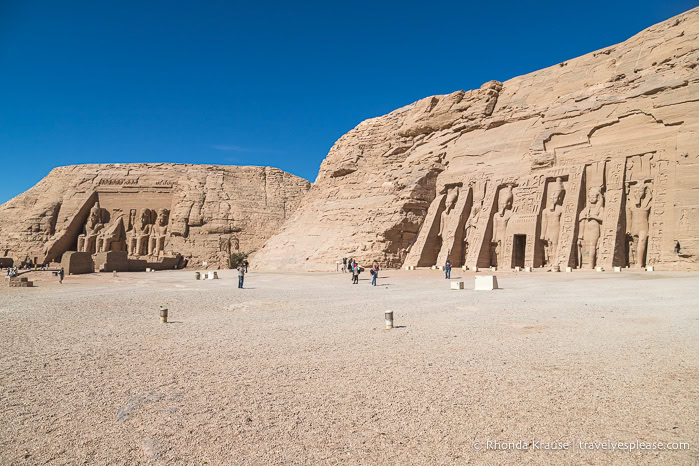
Exploring the Abu Simbel Temples was a fascinating delight, from gazing up at the colossal statues on the grand facades to discovering ancient stories portrayed in reliefs on the walls. It’s not a place to rush through, so I’m glad I visited with a private guide and not a big tour group.
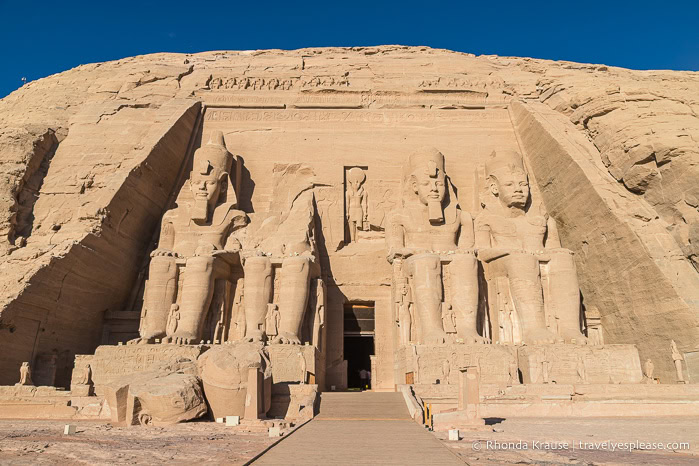
Here’s a look at my Abu Simbel day trip from Aswan, including descriptions of the temples, my highlights, and tips for visiting. Before that, I’ll share a bit about the history of Abu Simbel and why it’s such a significant site.

About Abu Simbel
The Abu Simbel temple complex dates back to around 1264 BC, when King Ramesses II (also known as Ramesses the Great) was having temples built in the Nubia region as part of his ambitious building program.
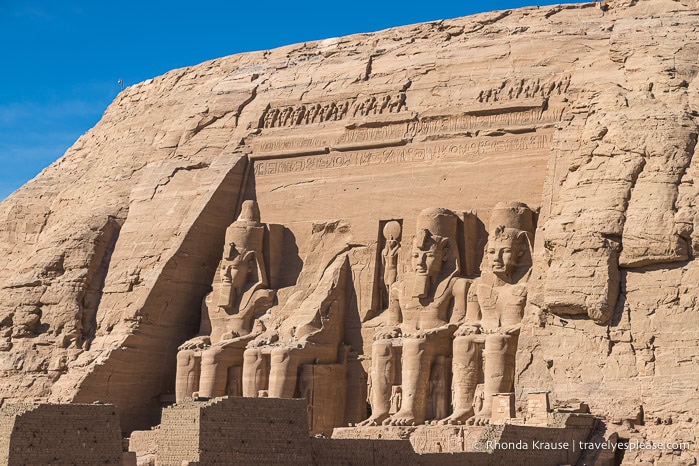
At Abu Simbel, two impressive temples were carved out of the mountainside. The largest one, known as the Great Temple, was dedicated to Ramesses II himself, along with the gods Amun, Ra-Horakhty, and Ptah. The smaller temple was dedicated to his first wife, Queen Nefertari, and the goddess Hathor, hence the name Temple of Hathor and Nefertari (also called the Small Temple).
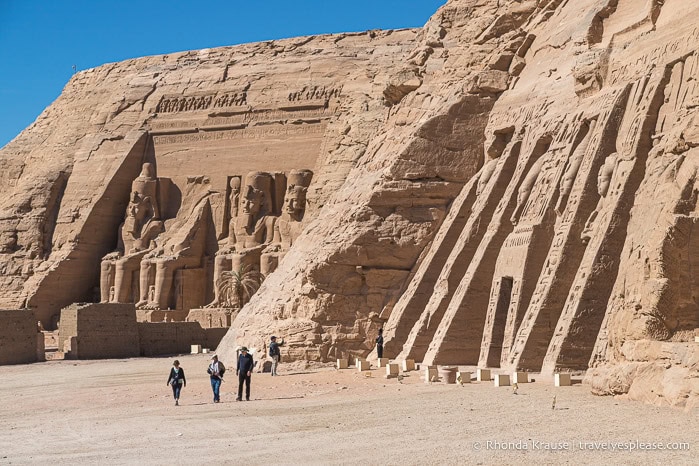
As time passed, the Abu Simbel temples were neglected and became covered by sand. In 1813, the temples were rediscovered by Swiss traveller and researcher Johann Ludwig Burckhardt, who also rediscovered the ancient rock-cut city of Petra in Jordan. He told Italian explorer Giovanni Belzoni about his discovery and in 1817, Belzoni travelled to Abu Simbel to excavate the temples.
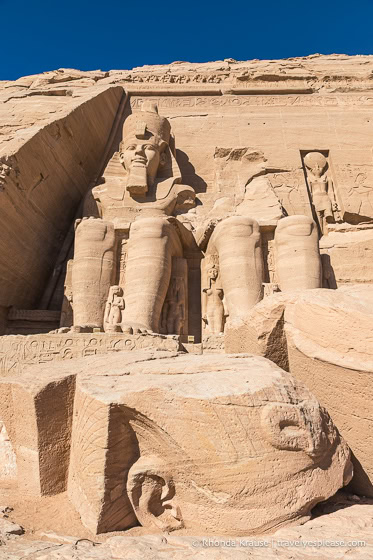
In 1959, when plans to build the Aswan High Dam across the Nile threatened to submerge the Abu Simbel temples, a campaign to save them was started. It was decided to move the temples 200 m/656 ft to the northwest and 65 m/213 ft higher than their original location.
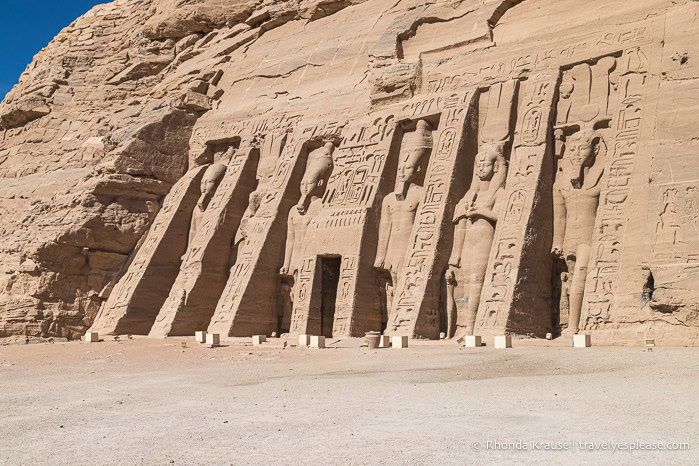
From 1964 to 1968, UNESCO led an international team of engineers, archaeologists, and heavy equipment operators to dismantle and relocate the temples. The temples were cut into approximately 1042 large blocks, lifted to the new site, and reassembled in an artificial mountain. Both temples were constructed under a concrete dome covered with sand and rocks to look like the natural cliffs in which they were originally carved.
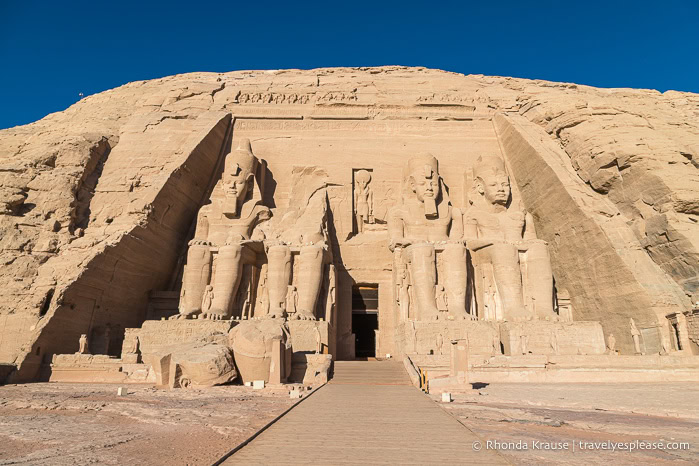
The Abu Simbel temples were designated a UNESCO World Heritage Site in 1979 under the name Nubian Monuments from Abu Simbel to Philae. It is now a top tourist site welcoming hundreds of visitors each day.
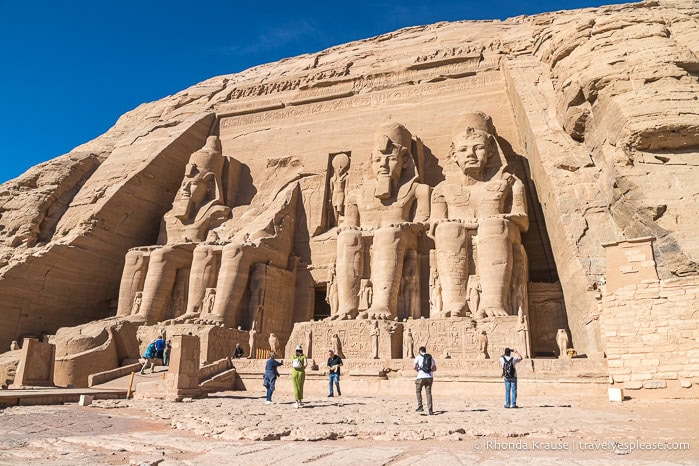
Visiting the Abu Simbel Temples- My Experience
My Abu Simbel day trip from Aswan started when my guide picked me up at 4:00 am so that we would arrive shortly before the site opened. For safety reasons, there is a checkpoint on the highway leaving Aswan where foreign tourists have to assemble so they can travel in a convoy while it’s dark. We waited about 30 minutes before the road was opened to us and a long line of tourist buses.
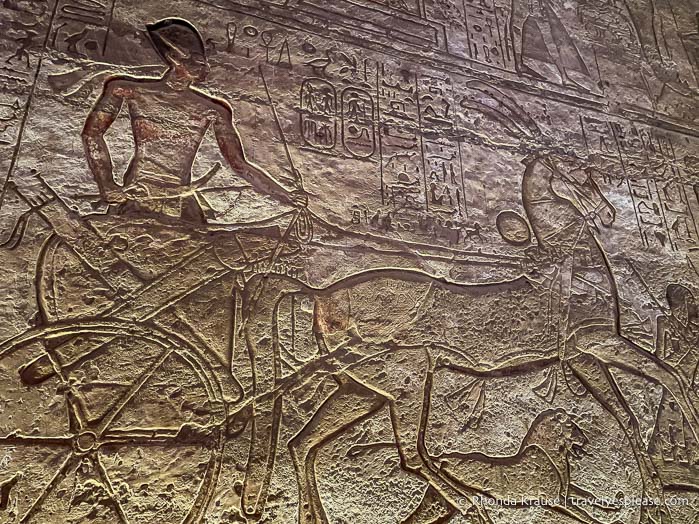
After arriving at Abu Simbel, I bought my entrance ticket then hurried down the path along Lake Nasser towards the temple complex, which was out of view.
Turning the corner, my first glimpse of the Great Temple was a side view of the facade and its four colossal statues of Ramesses II carved into the rock. It felt surreal to see the temple in real life, after admiring it in photos for so long, and I couldn’t contain my excitement to explore it before busloads of people arrived.
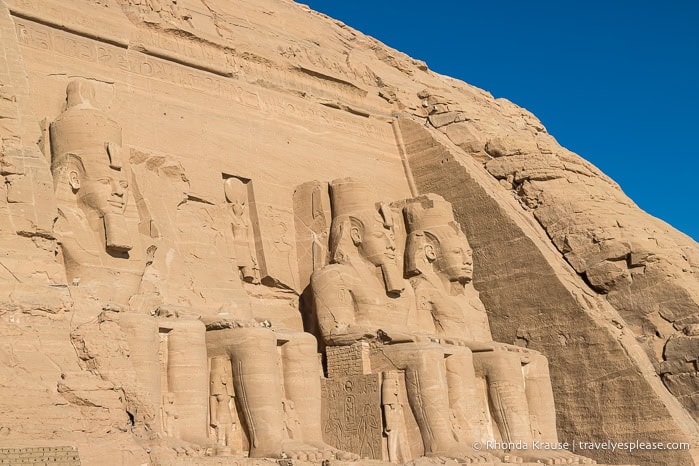
I took my time visiting the rooms inside Abu Simbel’s Great Temple, then walked over to the Small Temple to see what it was like. I ended my day trip to Abu Simbel by looking at some displays in the visitor centre.
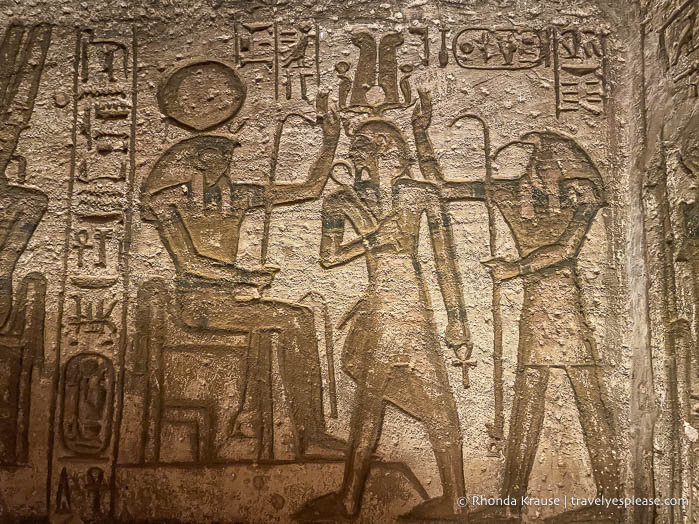
Temple of Ramesses II- The Great Temple at Abu Simbel
The entrance to the Great Temple at Abu Simbel is flanked by two pairs of statues of Pharaoh Ramesses II sitting on a throne. Most striking is the size of the statues, at 20 m/66 ft tall, but only three of them are intact. One of the statues was damaged during an earthquake, and its broken head and torso were left lying on the ground instead of being restored.
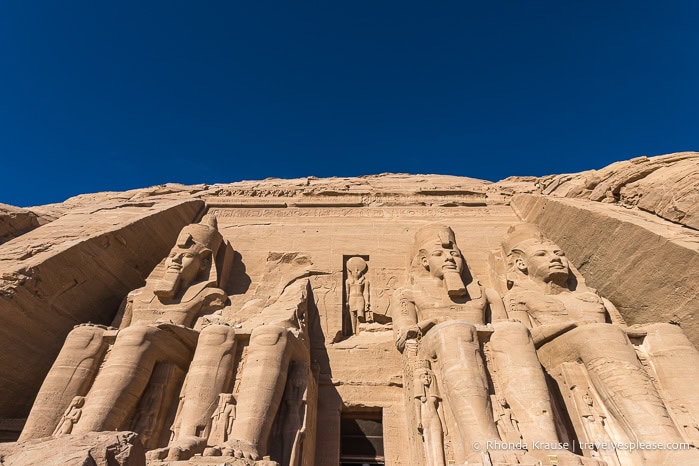
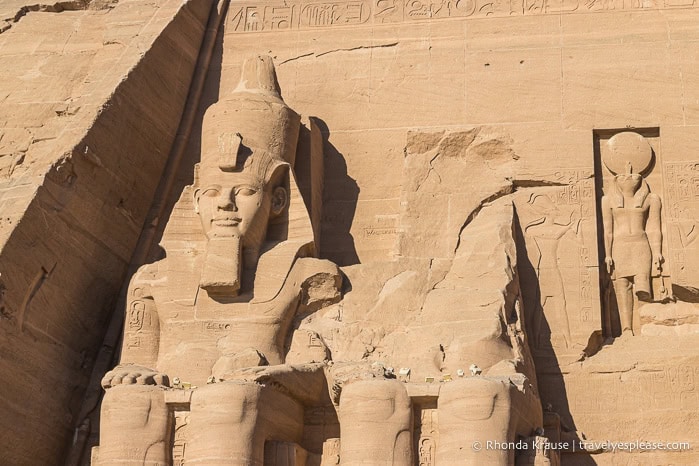
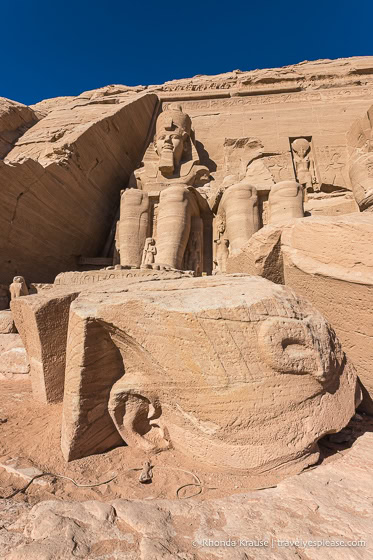
At the feet of the statues are smaller sculptures of Ramesses’ family, including his wife Queen Nefertari, his mother Queen Tuya, his first two sons, and his first six daughters.
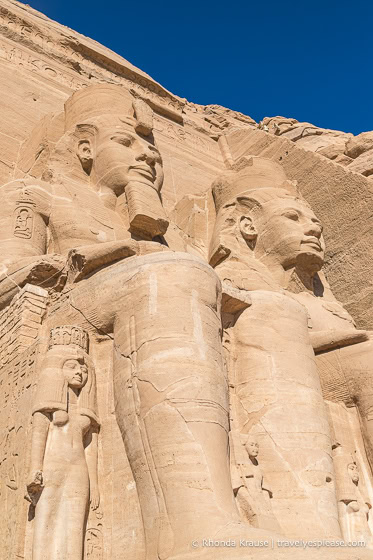
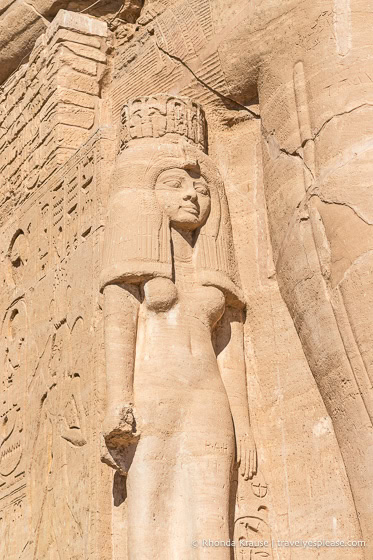
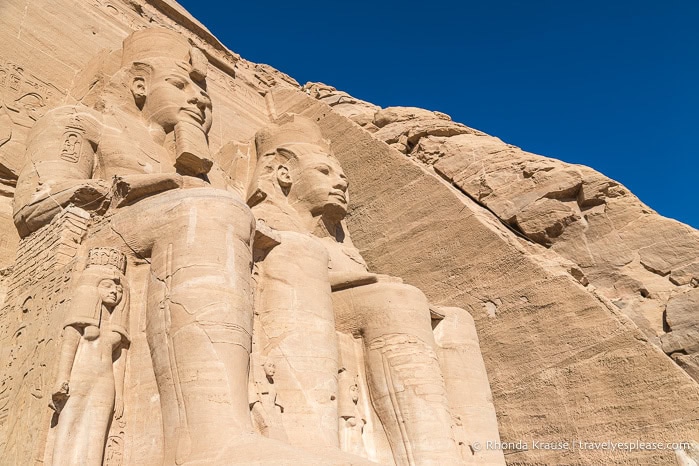
The base of the thrones are decorated with hieroglyphs and cartouches on the front and reliefs of enemies of Ramesses II on the side. On a lower platform in front of the thrones are several more small stone statues.

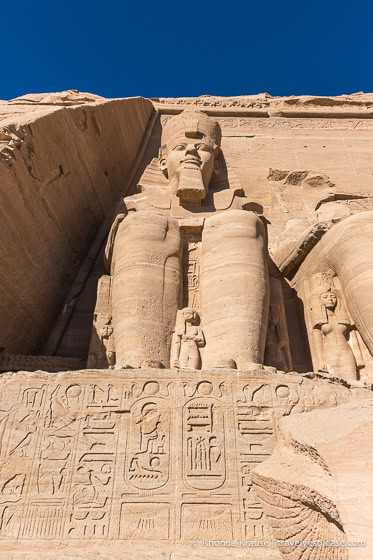
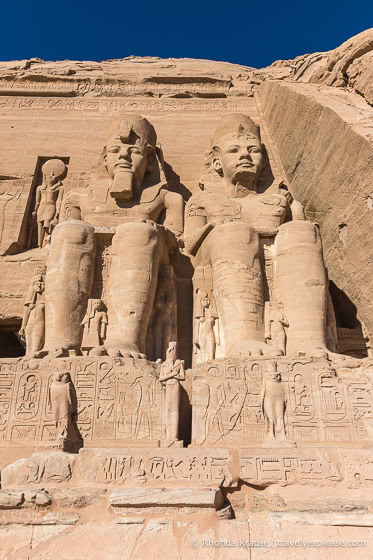
In a niche above the doorway is a sculpted image of Ra Horakhty, the falcon-headed sun god. On each side are reliefs showing Ramesses II worshipping Ra.
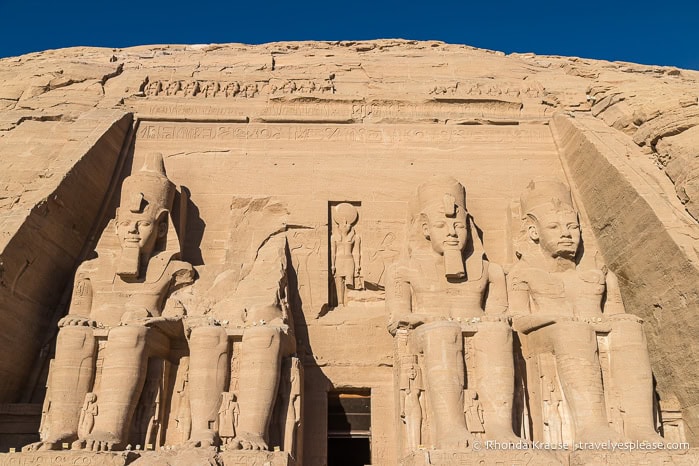
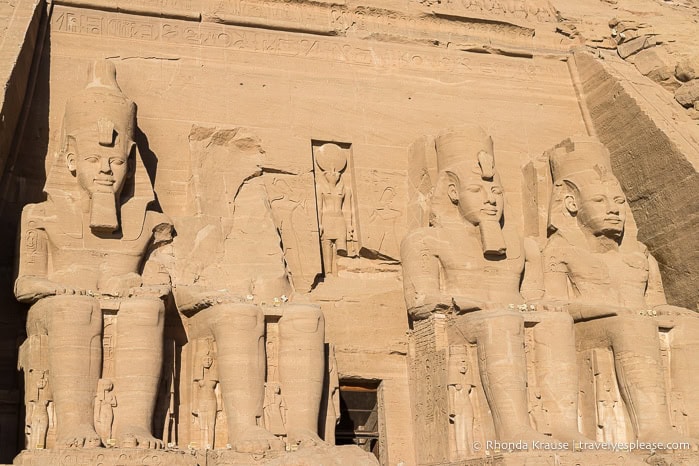
At the very top of the facade is a damaged frieze depicting a row of 22 baboons with upraised arms as though they are worshipping the sun. Baboons were revered by ancient Egyptians and associated with the god Thoth, so I saw them portrayed in several of the tombs and temples I visited.
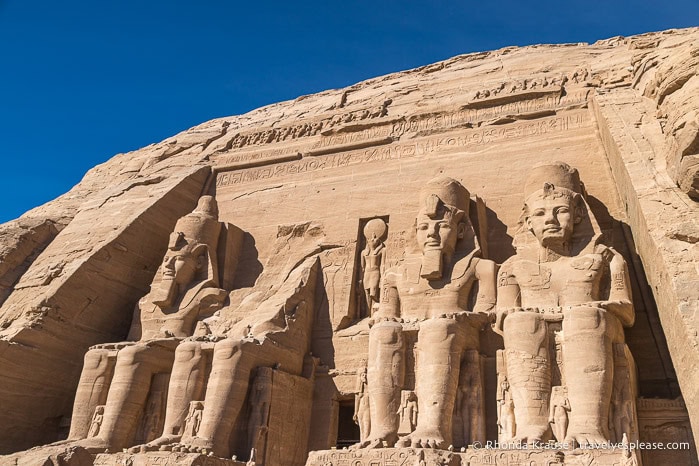
After admiring and photographing the facade, I eagerly headed inside the Great Temple of Ramesses II, curious to see what artistic treasures it held.
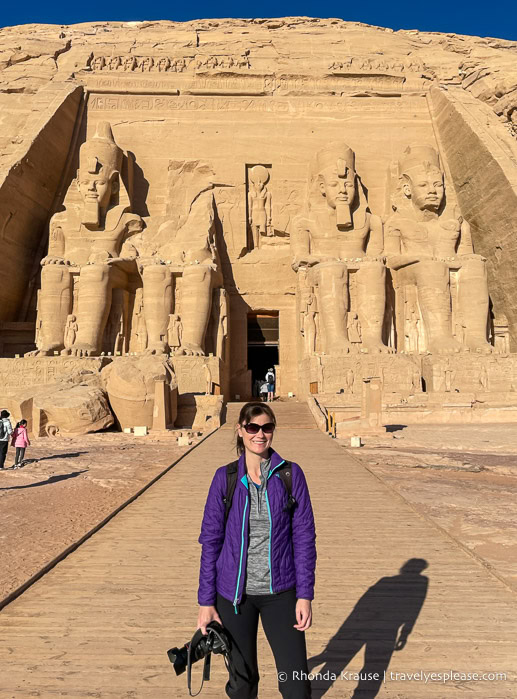
I wasn’t sure what to expect inside Abu Simbel’s Great Temple, but it wowed me just as much as the outside. There were statues, relief-covered walls, and more rooms than I anticipated, with two halls, a sanctuary, and six side chambers (a unique layout for Egyptian temples).
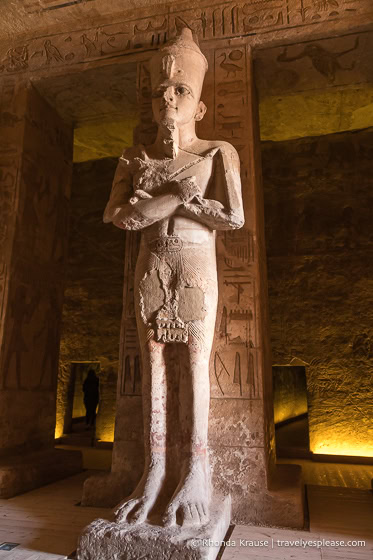

Upon entering the hypostyle hall, I was met with eight tall pillar statues depicting Ramesses II as Osiris, god of the afterlife and resurrection (among other things). The statues on the left wear the white crown (hedjet) of Upper Egypt and the statues on the right bear the double crown (pschent) of Upper and Lower Egypt. The figures have their arms crossed to signify the power of kingship.
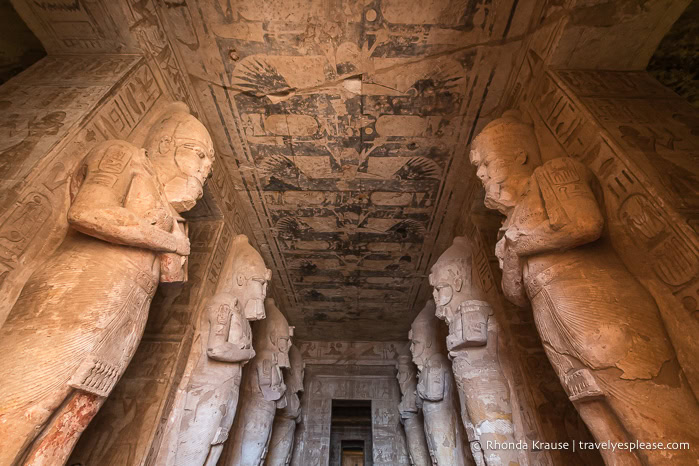
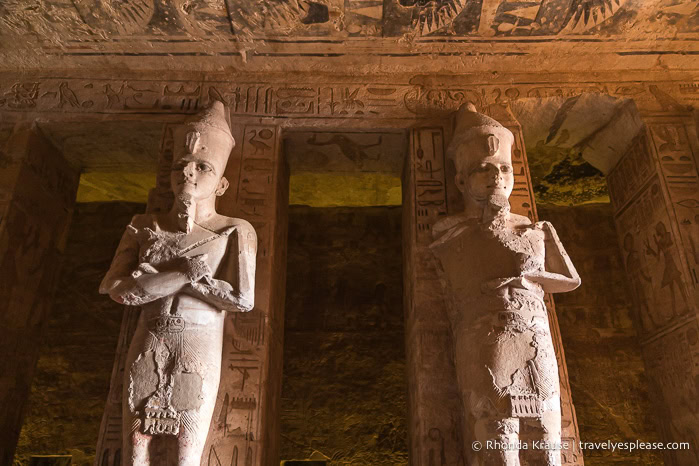
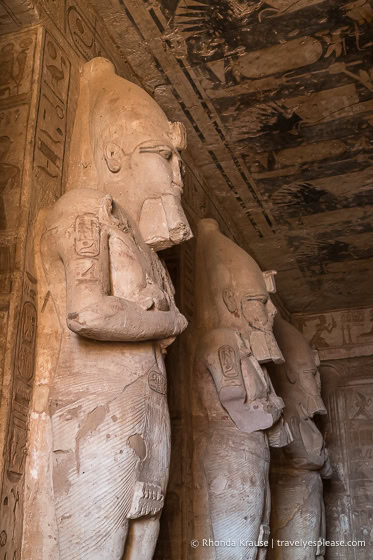
For me, the most impressive thing about the hypostyle hall’s statues was their size. People looked so small standing next to them- I only came up to the knees!
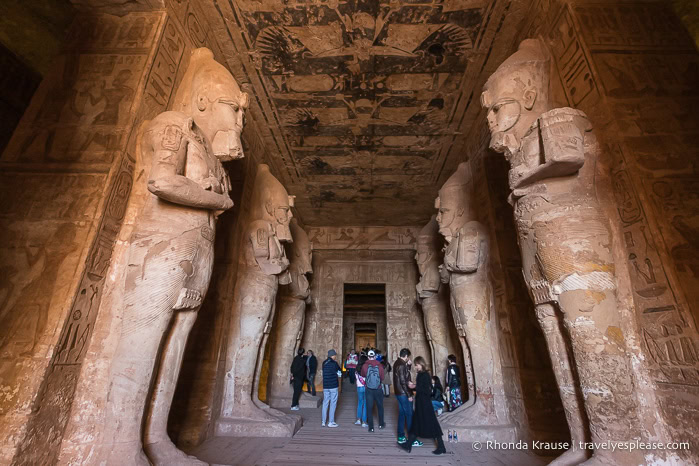
The hypostyle hall also has several eye-catching reliefs covering the walls. They show battle scenes from the military campaigns Ramesses II waged, including the Battle of Kadesh and conquests in Libya and Nubia. The reliefs I found most interesting were one showing the king on a chariot shooting arrows at a fortress, one of him killing a Libyan enemy, and two of the king striking his Nubian and Libyan enemies.
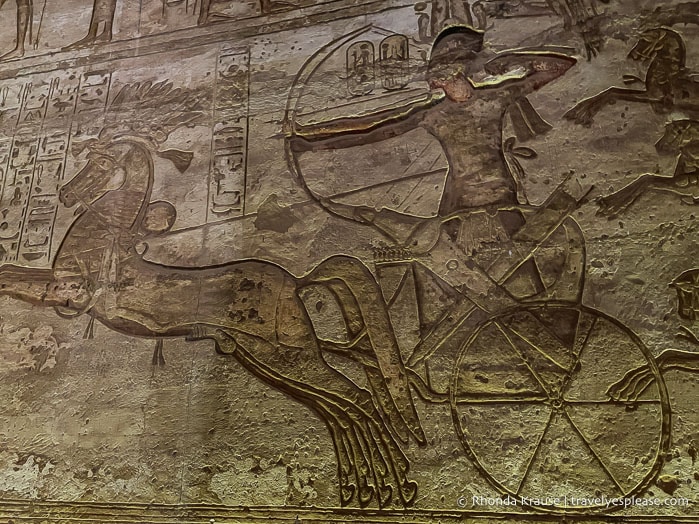
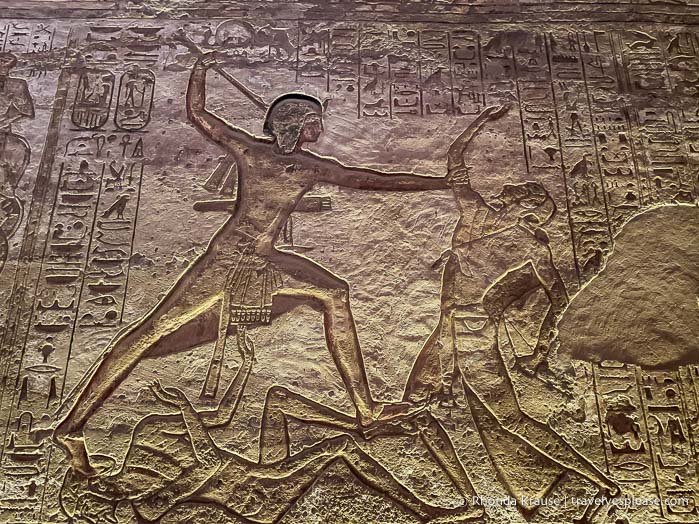
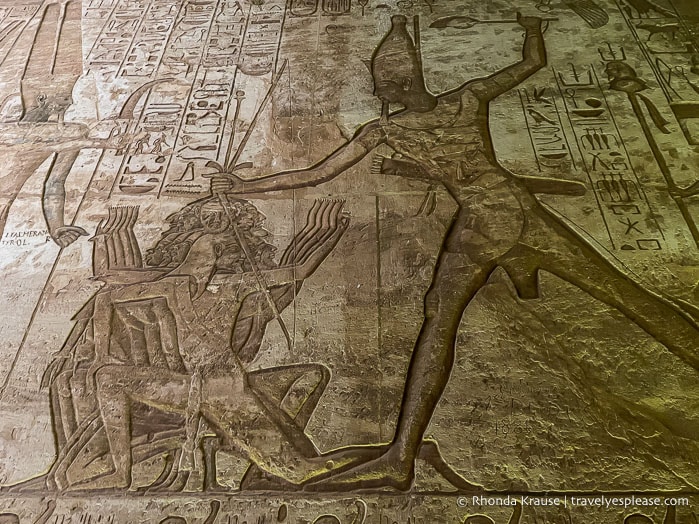
The hypostyle hall is the largest room in the Great Temple of Ramesses II, at 18 m/59 ft long and 16.7 m/55 ft wide. As is typical of Egyptian temples, the rooms decrease in size from the entrance.
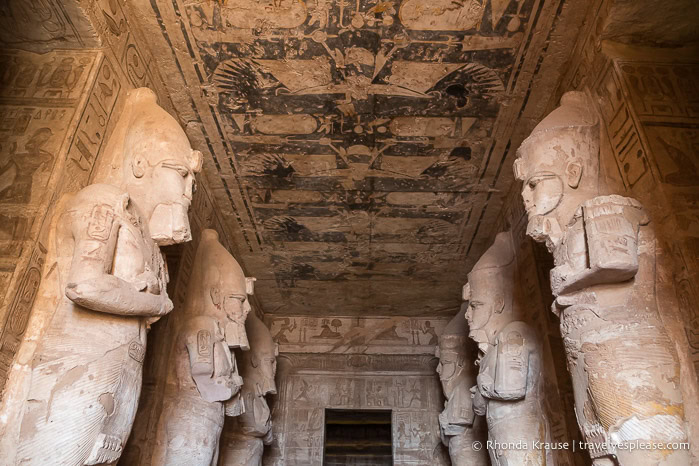
Beyond the hypostyle hall is a smaller pillared hall with scenes of Ramesses and Nefertari worshiping ceremonial boats used to carry statues of the gods. This hall leads to a sanctuary at the end of the temple.
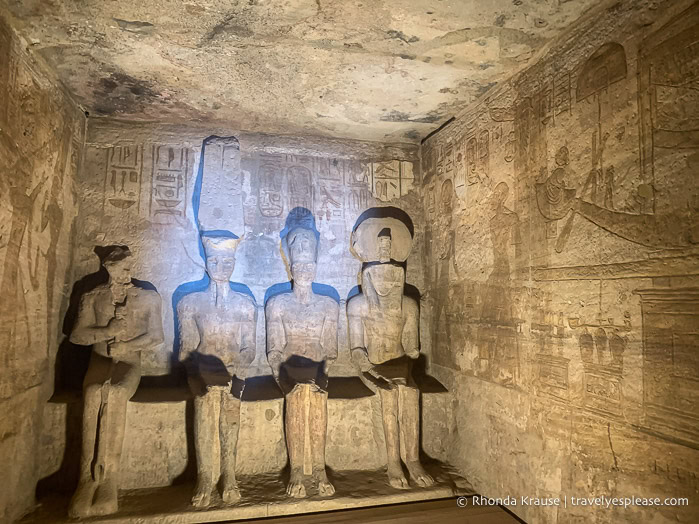
The sanctuary houses four rock-cut sculptures of, from left to right, Ptah (the creator god), Amun-Ra (a fusion of Amun, king of the gods, and Ra, the sun god ), a deified Ramesses II, and Ra-Horakhty. It’s believed that the temple was positioned so the sun’s rays would illuminate the sanctuary statues on February 22 and October 22, allegedly Ramesses II’s coronation day and birthday, respectively (there is no evidence to support this, but the dates must have been significant for some reason).
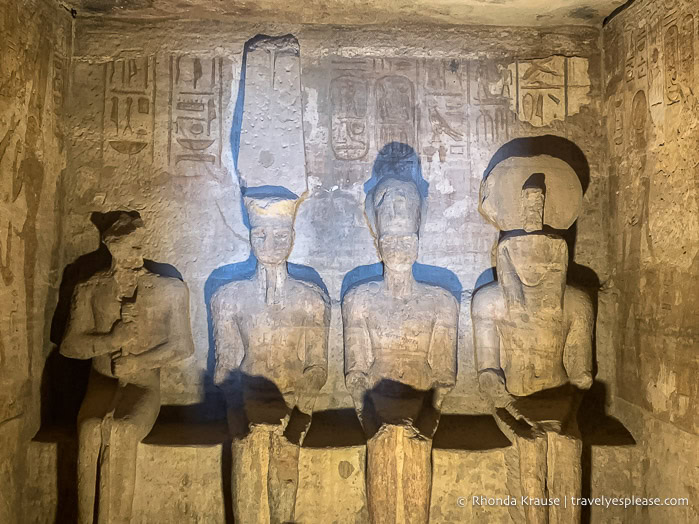
After exploring the temple’s central rooms, I visited the six side chambers accessible from the hypostyle hall. These narrow, rectangular rooms have reliefs on the walls depicting scenes of offerings to the gods.

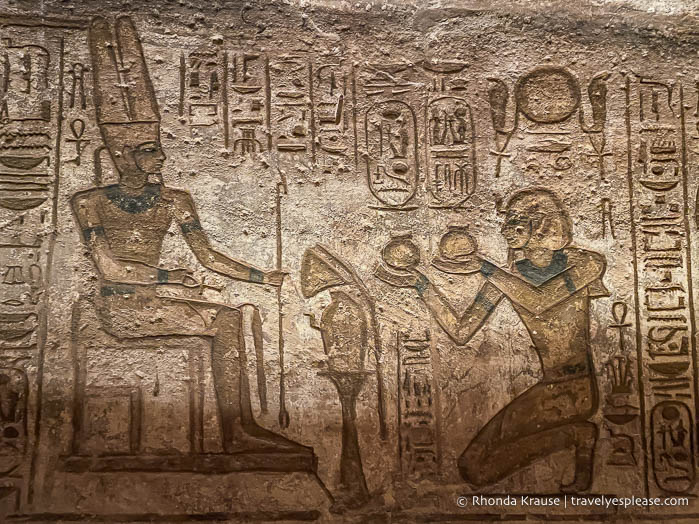

As I looked around these rooms, it was fun to challenge myself to see which gods I could identify. Ra frequently appeared. I also noticed Hathor, Horus, Amun, Thoth, Ptah, and Anubis.
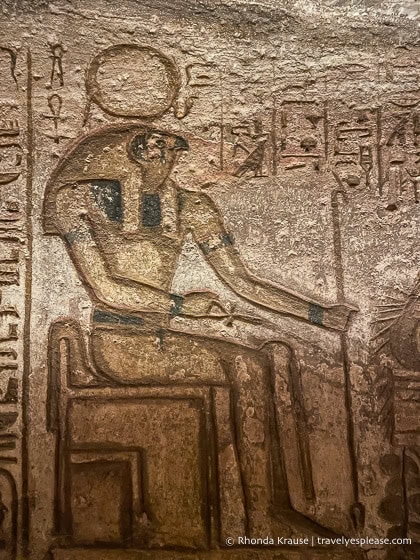
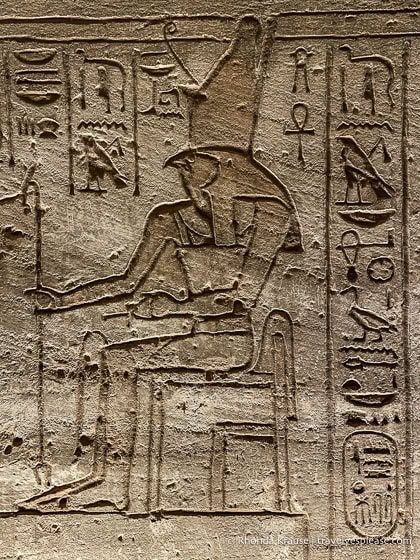
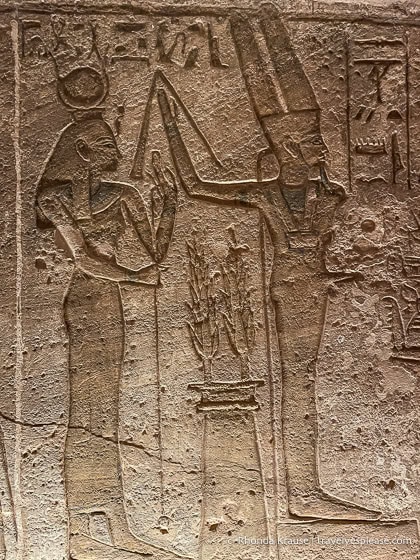
One of the side chambers has several empty niches carved into the wall with cartouches decorating the space between them. Another chamber has one plain wall, the only unadorned wall in the temple.
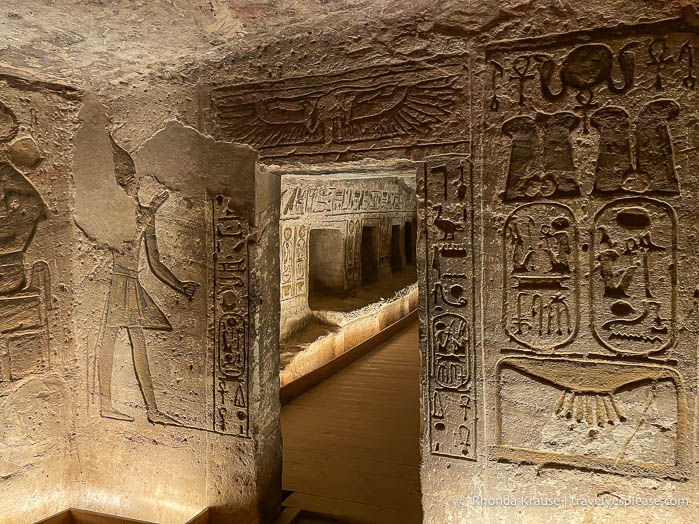
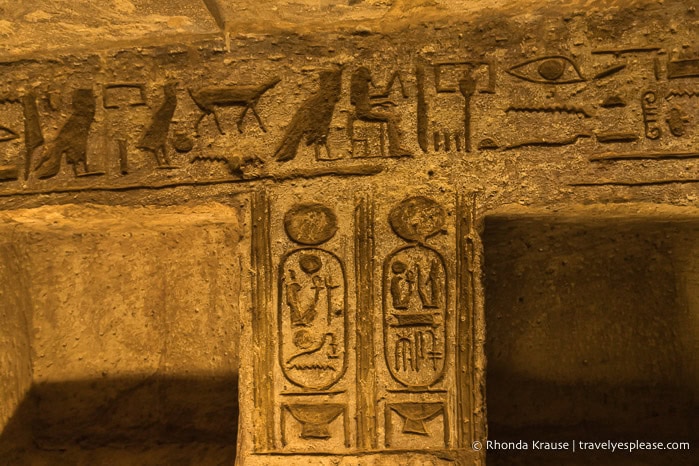
After visiting all the rooms inside Abu Simbel’s Great Temple, I walked over to the neighbouring Temple of Hathor and Nefertari to see what it looked like.
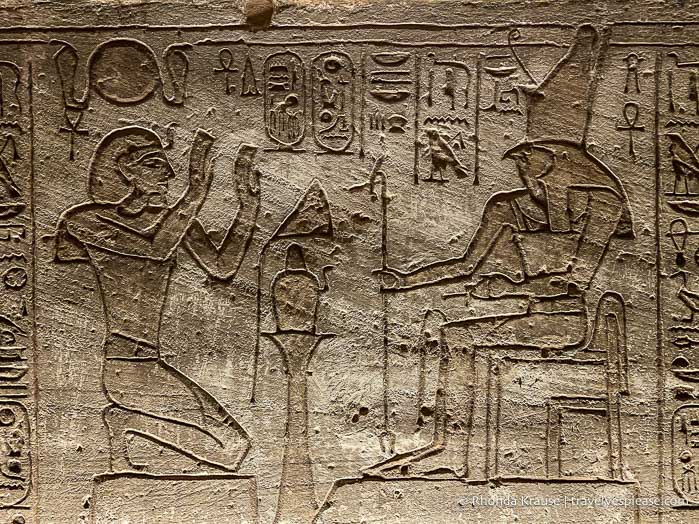
Temple of Hathor and Nefertari- The Small Temple at Abu Simbel
The rock-cut facade of the Temple of Hathor and Nefertari features six colossal statues of Ramesses II and his queen, Nefertari. It is rare in Egyptian art for a queen’s statues to be the same size as the king’s, but on this temple they all measure about 10 m/33 ft high.
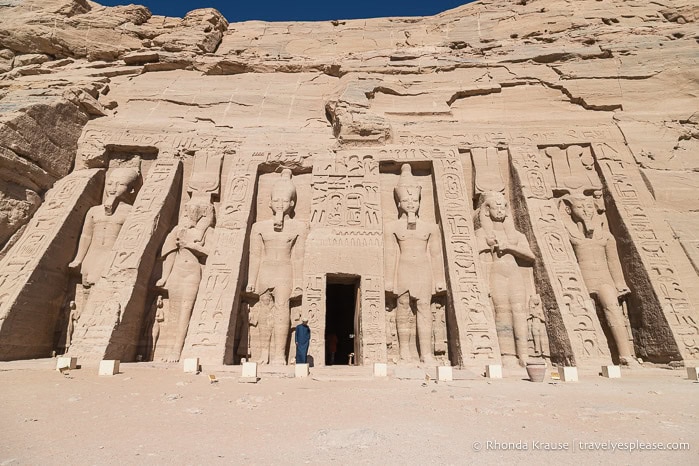
On each side of the doorway is one statue of Nefertari framed by two of the king. On the statues closest to the entrance, the king is wearing the white crown of Upper Egypt on one side and the double crown on the other. At the feet of the colossi are small statues of the sons and daughters of the royal couple.
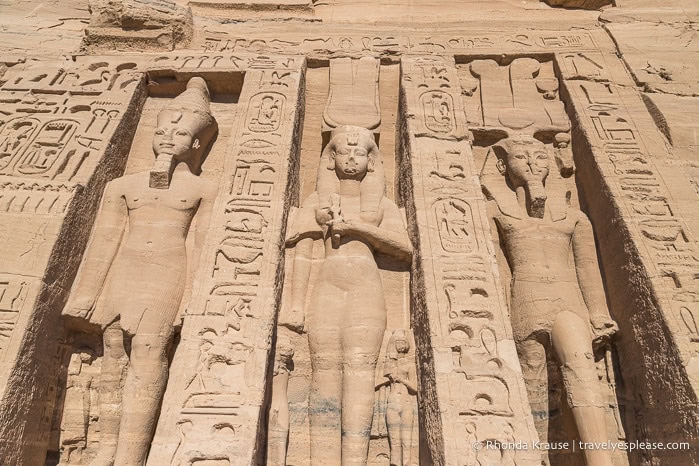
The rest of the facade is decorated with hieroglyphs and cartouches, so there’s less blank space than on the Great Temple.
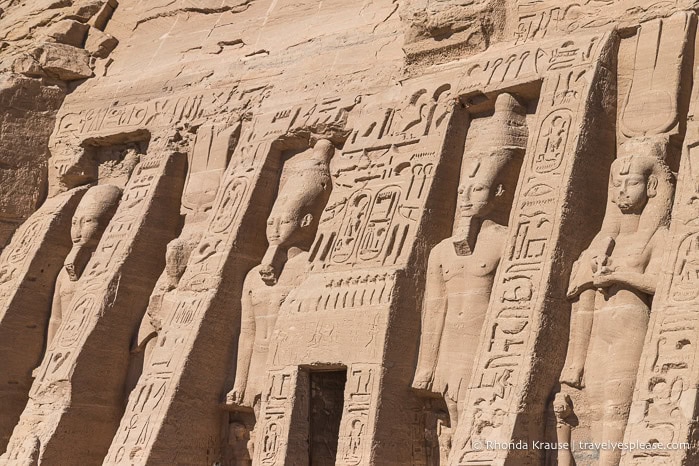
My first impression of the interior of Nefertari Temple was that it was similar, but simpler, than the Great Temple. The hypostyle hall has six pillars, but instead of statues, the capitals bear the face of Hathor, goddess of love, beauty, fertility, and music.
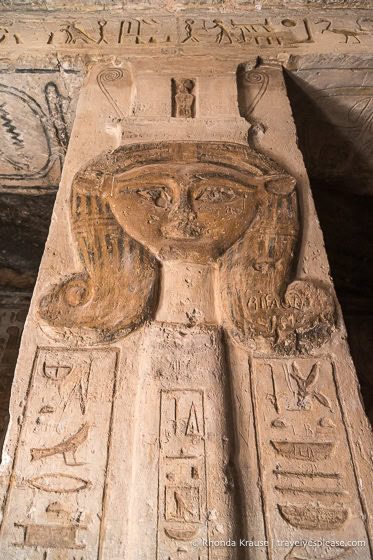
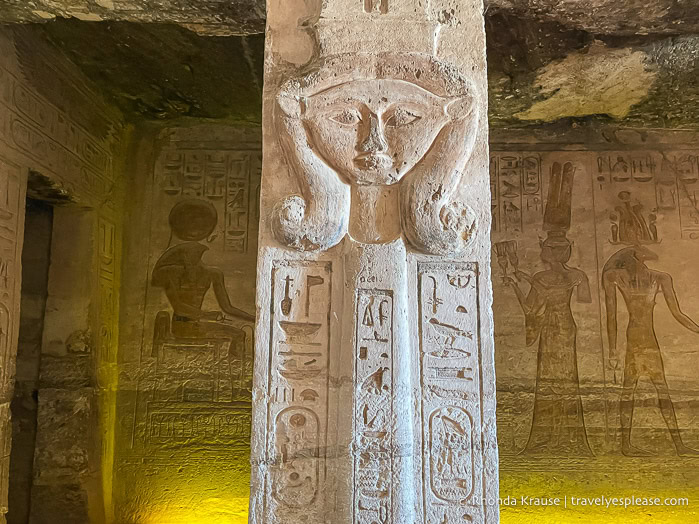
The hall’s pillars also have reliefs of the queen playing the sistrum (an instrument like a rattle) and of several different gods.
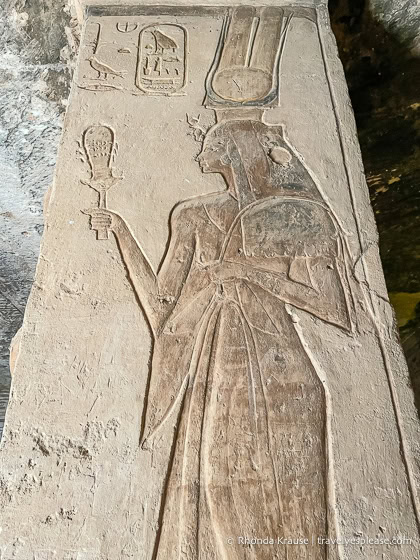
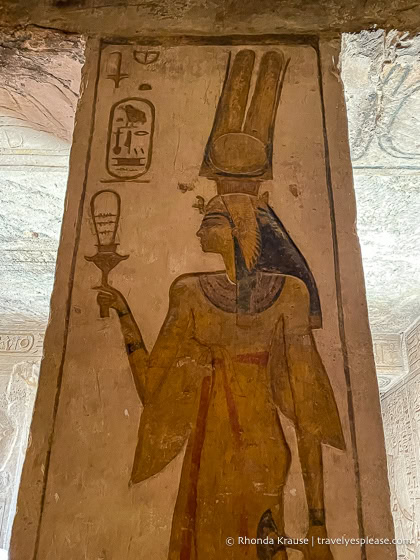
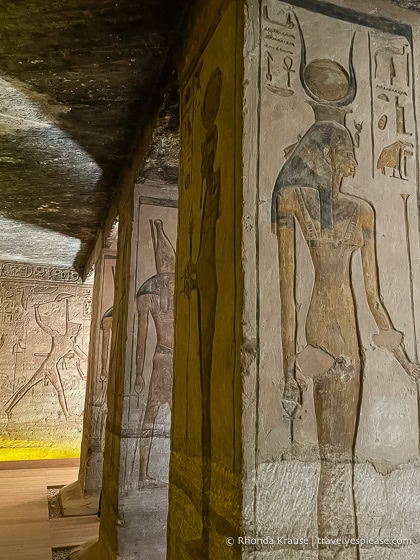
Like in the Great Temple, the walls in the hypostyle hall show scenes of Ramesses II striking his enemies, but here the queen looks on. There are also scenes of the queen making offerings to the goddesses Hathor and Mut, as well as the deification of the king by the gods Horus and Set.
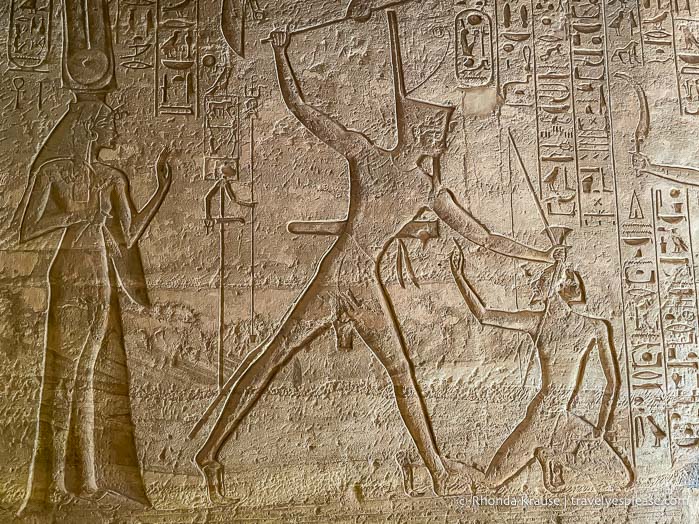
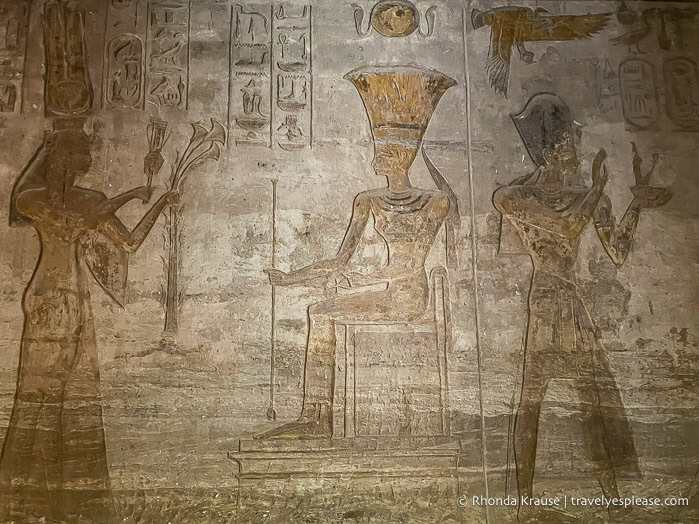
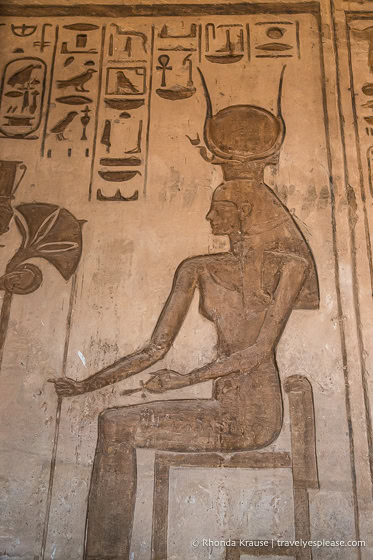
At the end of the hypostyle hall are three doorways giving access to a relief-decorated vestibule and the temple’s sanctuary. The back wall of the sanctuary has a niche with a rock-cut sculpture of Hathor as a divine cow, but I initially didn’t know what it was because it’s not in great condition.
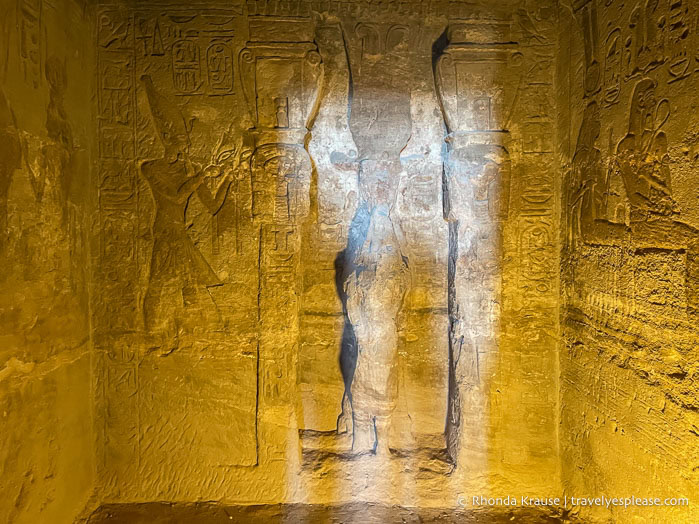
Visitor Centre at Abu Simbel
After visiting the Abu Simbel temples, I walked the road to the back side of the mountain and returned to the visitor centre at the entrance.
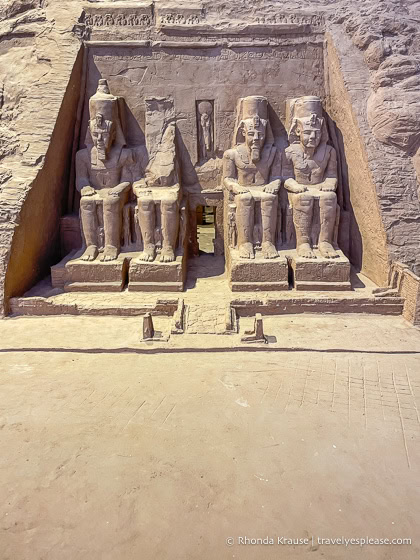
The small, simple visitor centre was a good place to learn more about Abu Simbel, especially how the temples were salvaged from their original location and reconstructed on higher ground. I enjoyed seeing the old photographs documenting the process of dismantling, moving, and re-erecting the temples at their current location. When looking at the pictures of Abu Simbel, it was hard to tell the difference between the original site and the new one. What an impressive project that was so well done!
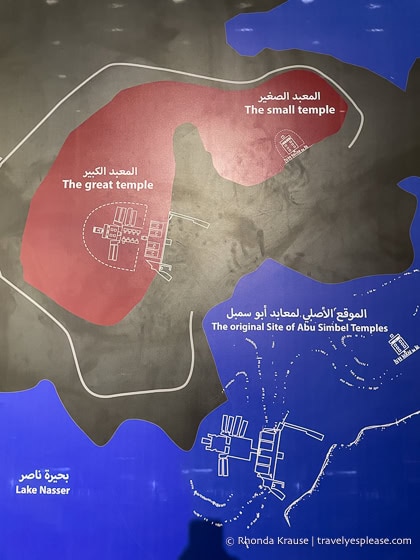
Final Thoughts About the Abu Simbel Temples
Visiting Abu Simbel was one of my favourite experiences during my two weeks in Egypt. There was so much to be fascinated by, from the architecture and art to the history and modern relocation of the temples.
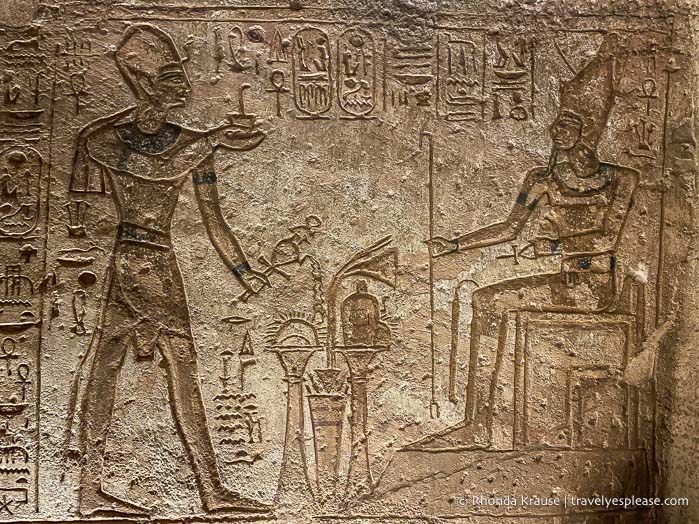
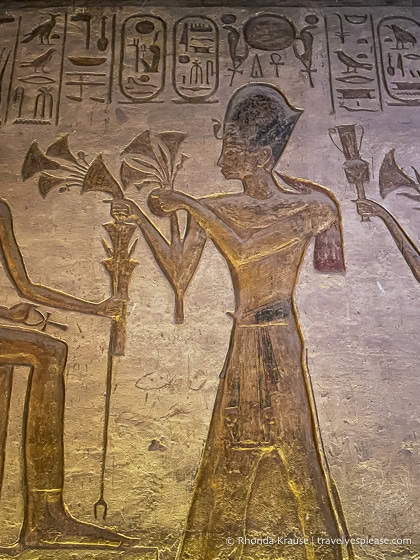
What impressed me most was the colossal statues on the facades of both temples. I’ll always remember the awe and excitement I felt walking up to those giant sculptures of Egyptian royalty before entering the temples of Abu Simbel. Ramesses II sure wasn’t humble!
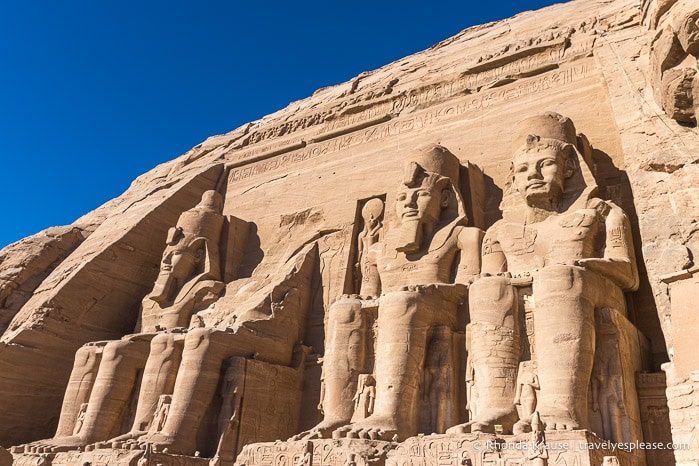
While the facades of the Great Temple of Ramesses II and the Temple of Nefertari were beautiful, the interiors were just as memorable. I loved the reliefs decorating the walls and pillars, and the stories they told. There was so much symbolism to look at! The towering statues in the Great Temple’s hypostyle hall were magnificent as well.
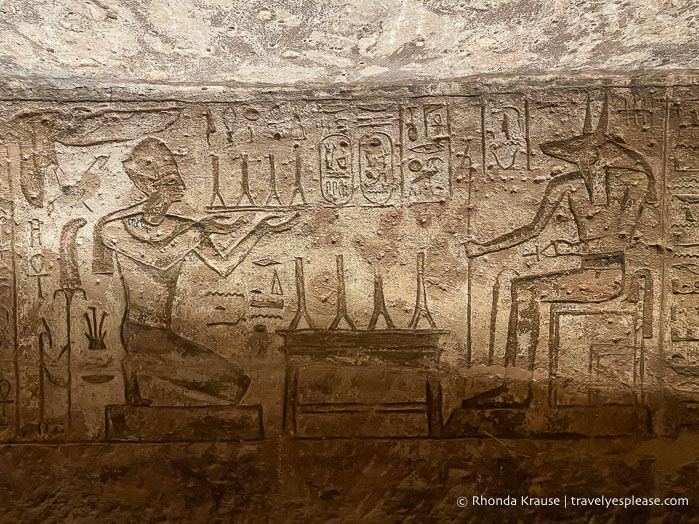
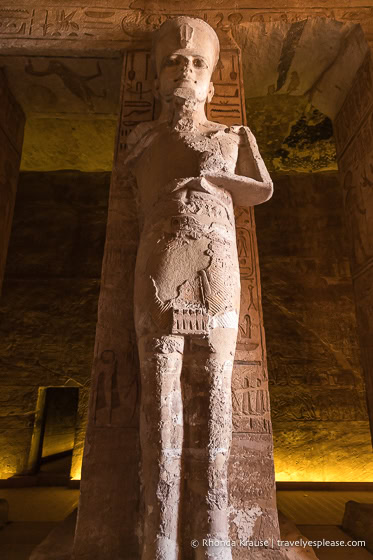
I’m thankful I arrived at Abu Simbel early in the morning so I could enjoy it for a while without the crowds. It was definitely worth leaving Aswan at 4:00 am to be one of the first people to visit the temple that day. Even though I spent almost 3 hours visiting Abu Simbel, I still didn’t want to leave. I’d love to go back one day for a second look and to see the Abu Simbel sound and light show.
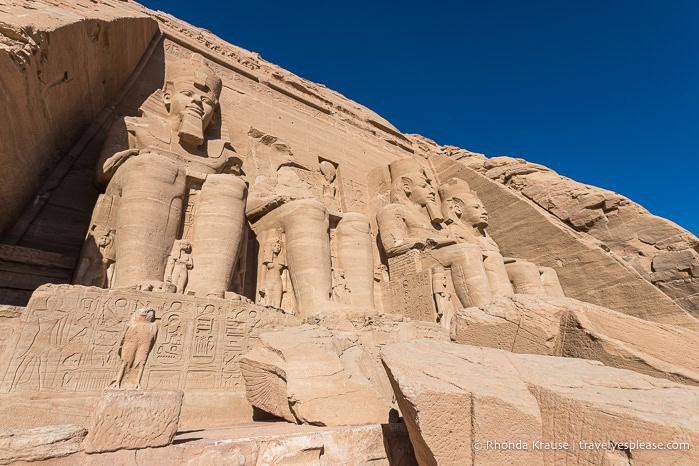
If the almost 300 km drive from Aswan has you questioning, is Abu Simbel worth visiting? I’d emphatically answer yes, the temples at Abu Simbel are worth the journey. The time it takes to get to Abu Simbel is a worthwhile investment to see one of the most unique and interesting temples in Egypt.
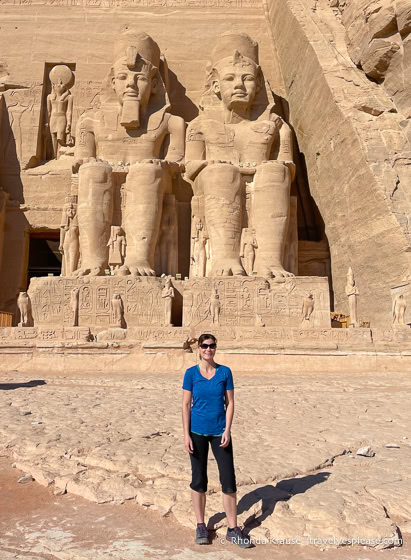
Pictures of Abu Simbel
Here are a few more pictures of Abu Simbel I took during my visit.
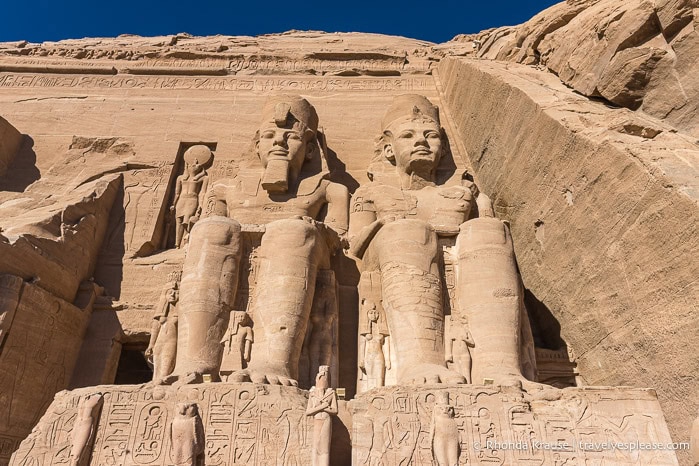
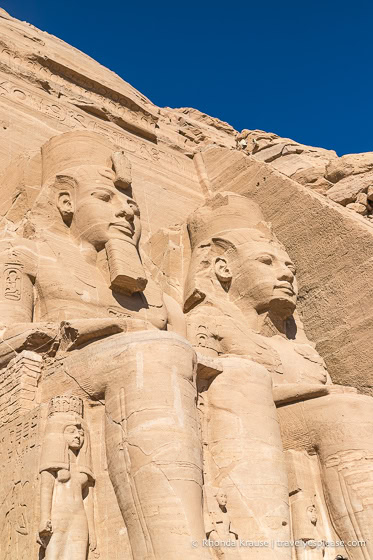
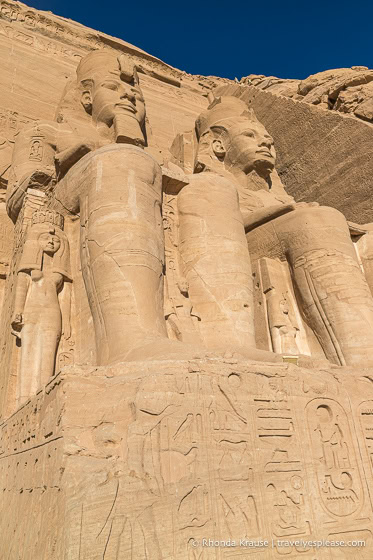
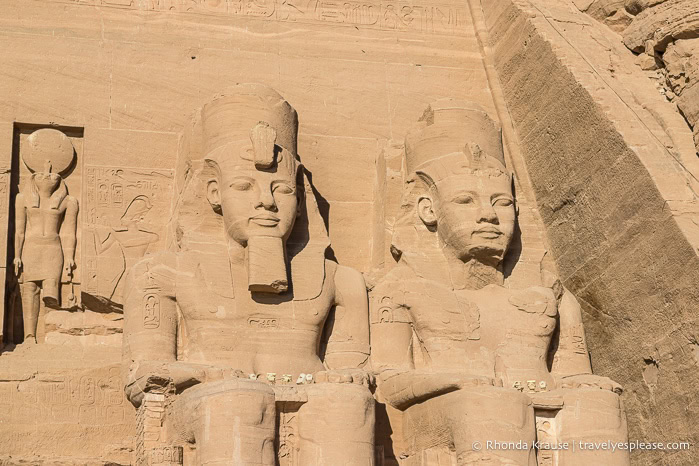
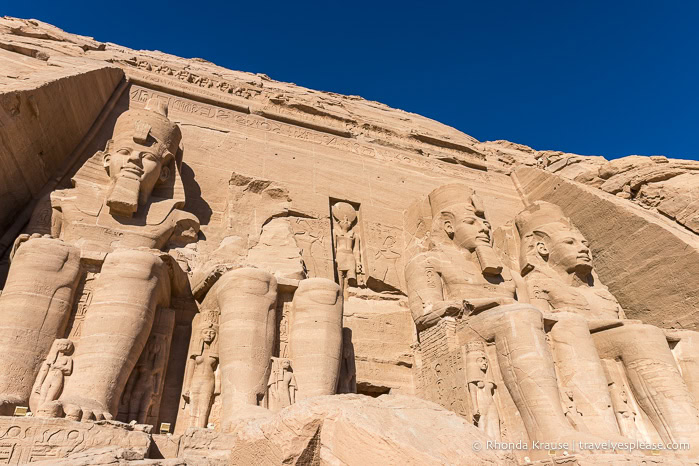
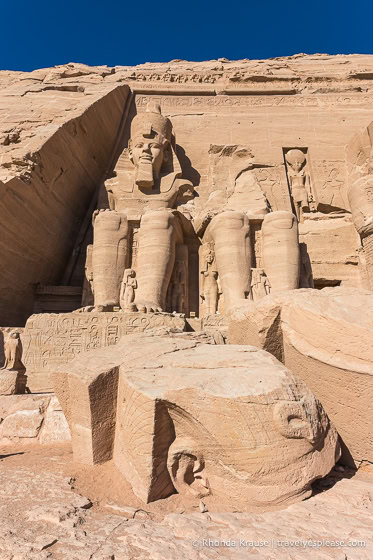
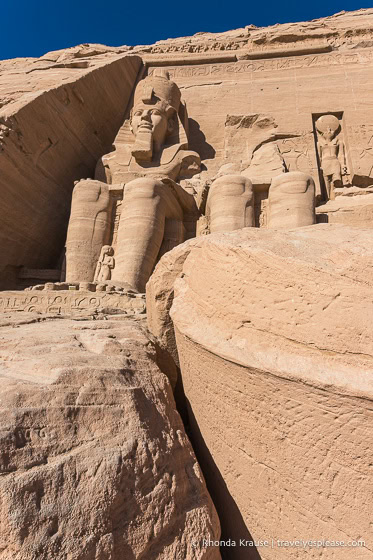
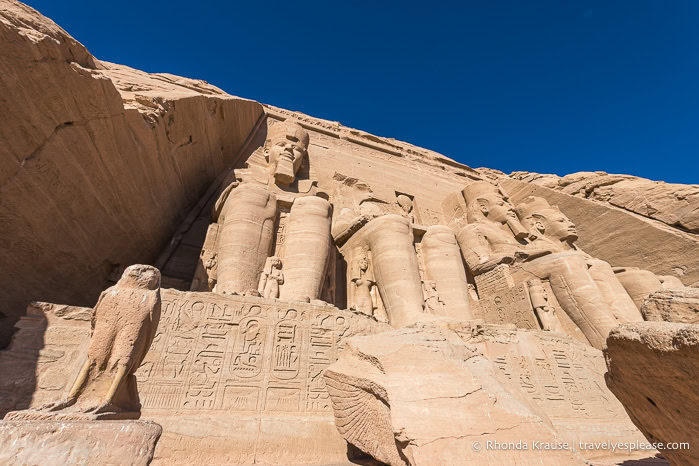
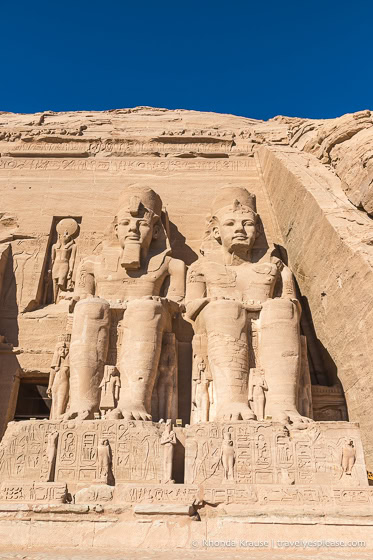
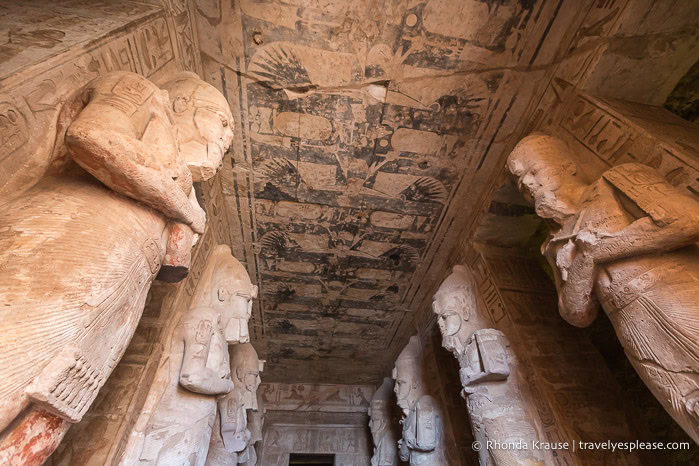
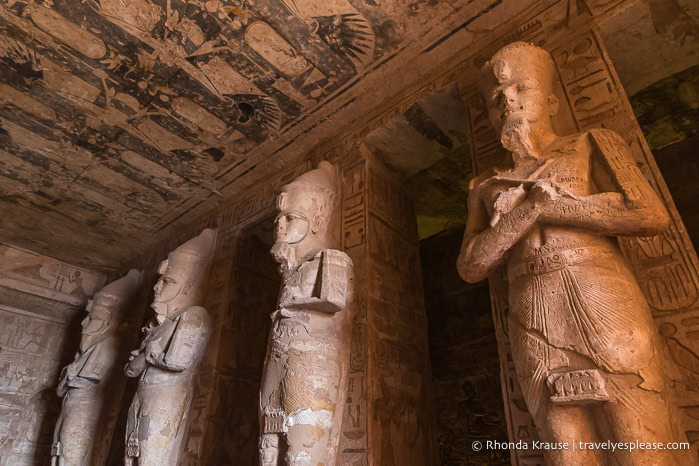
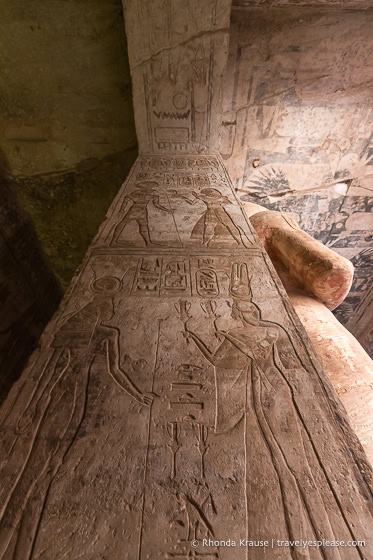
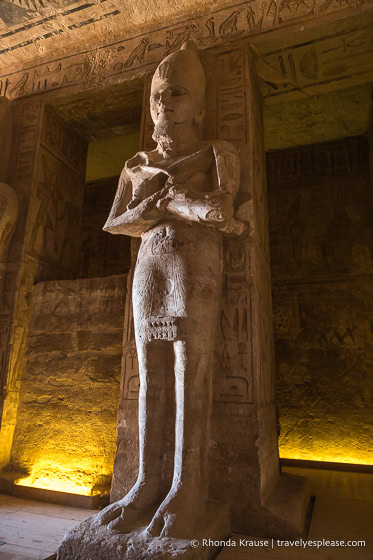
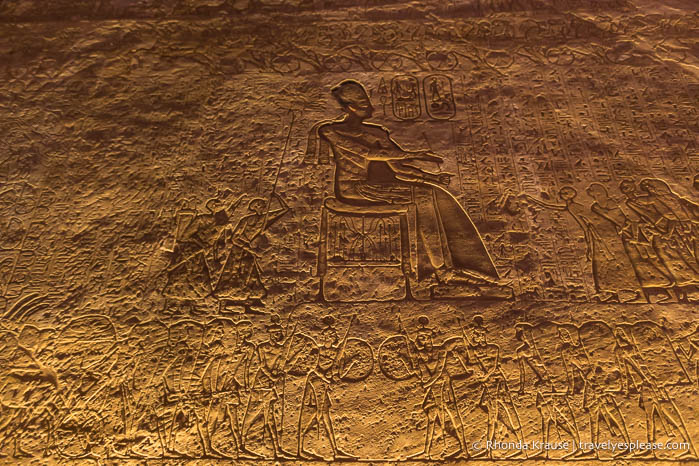
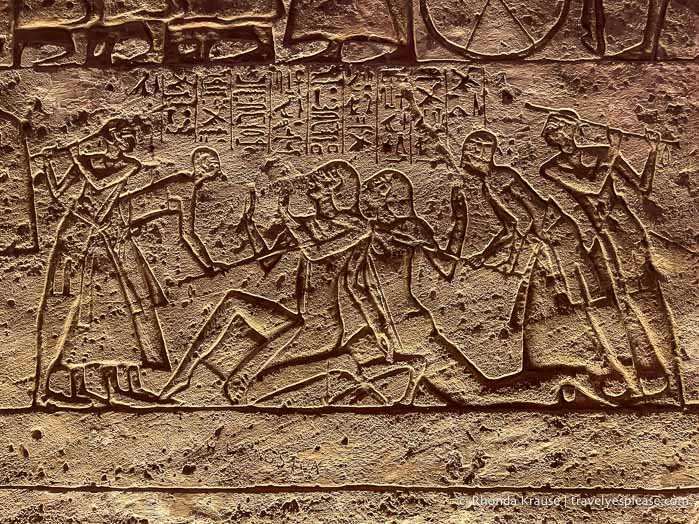
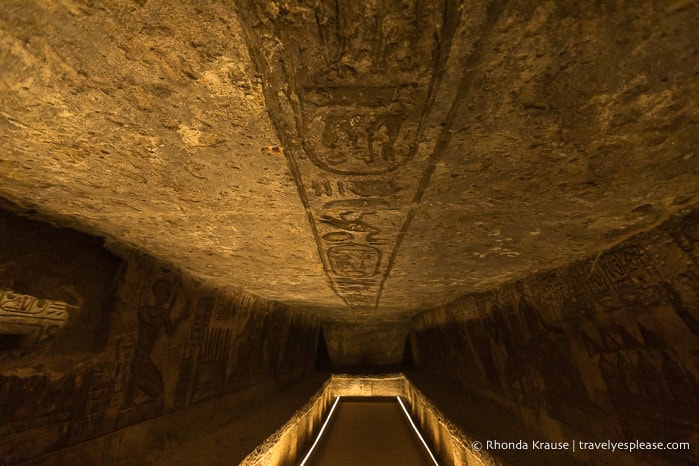
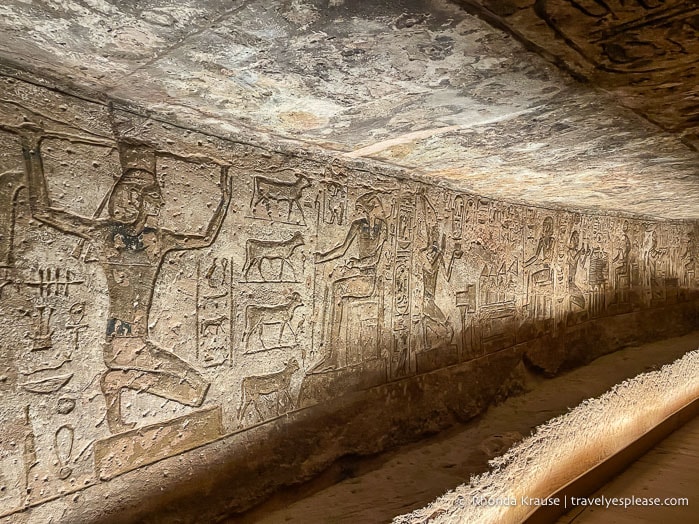

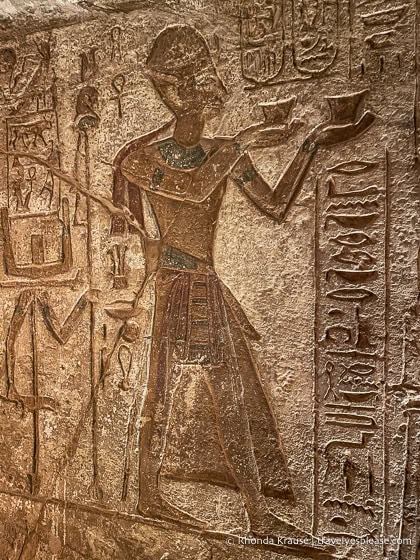
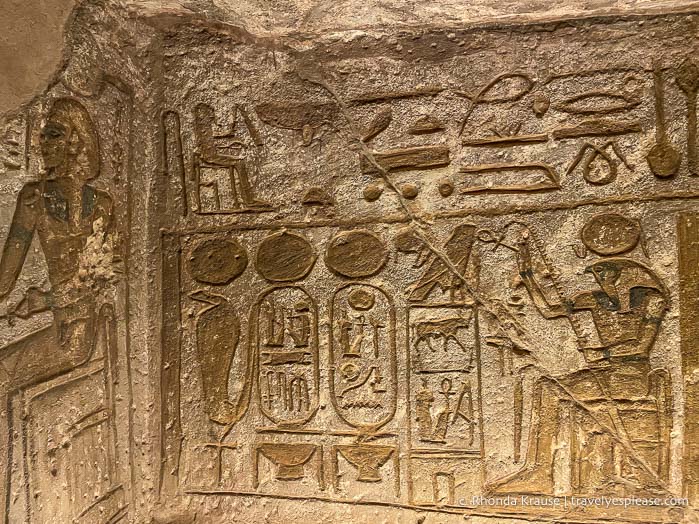
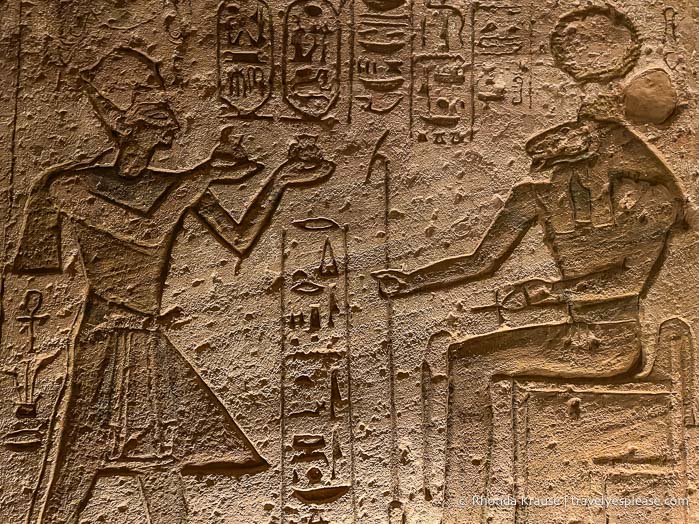
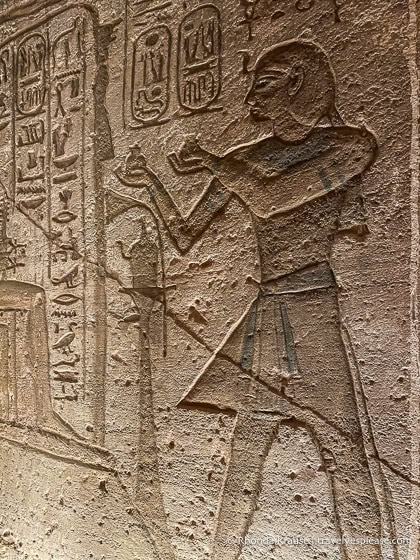
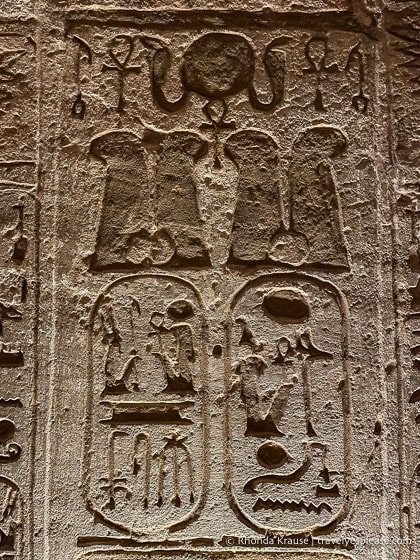
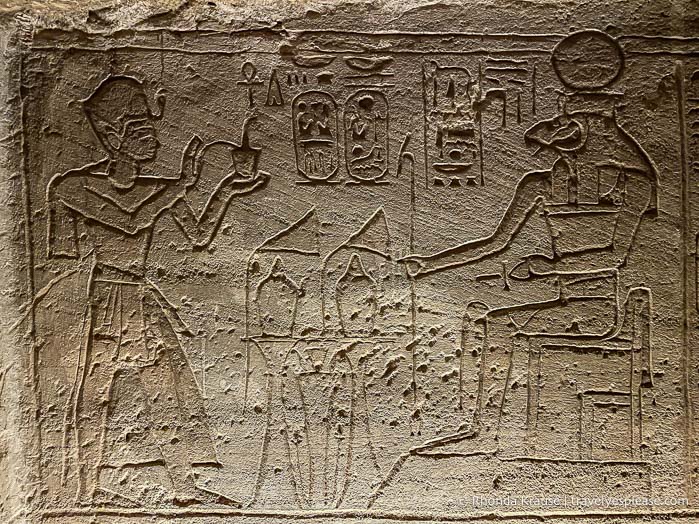
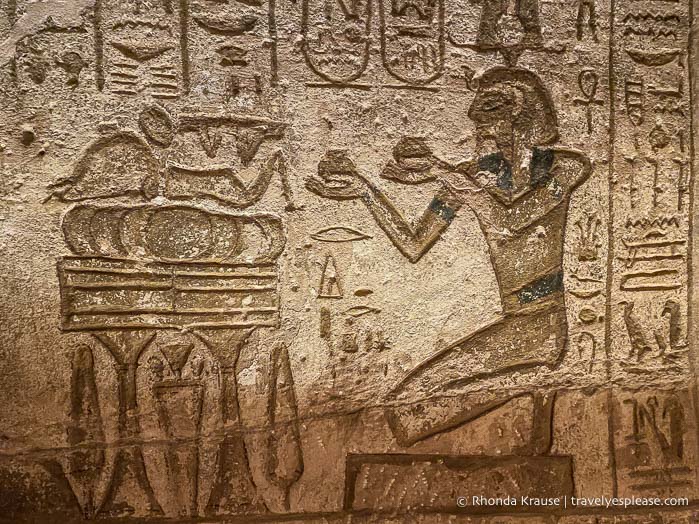
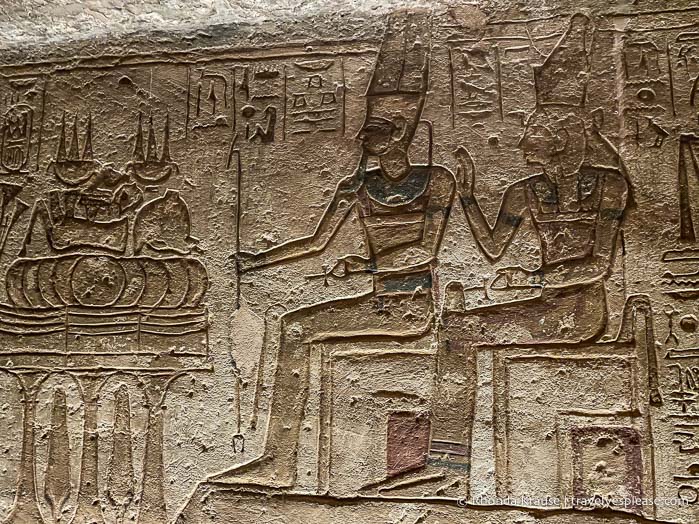
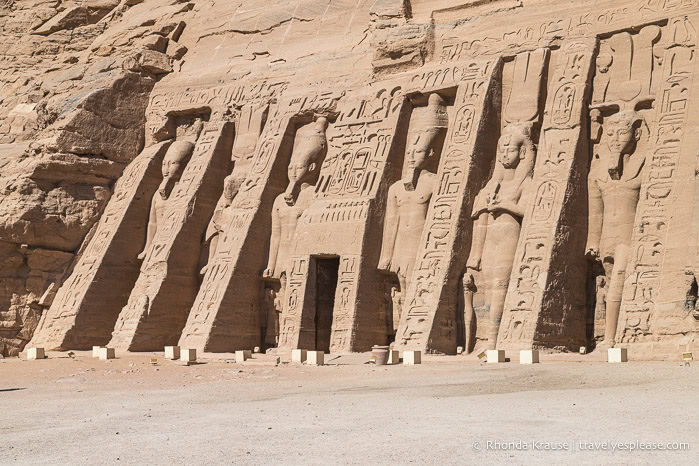
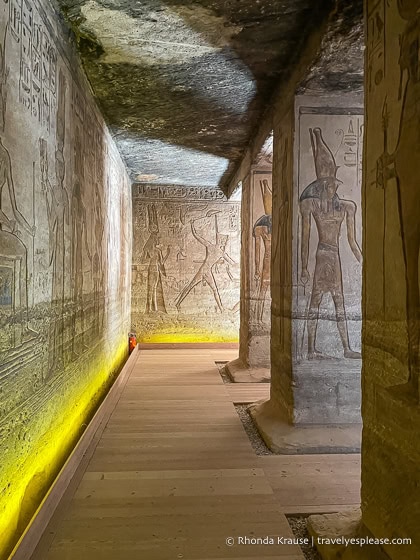
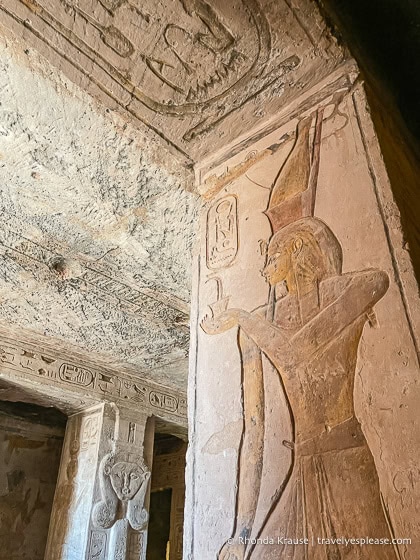
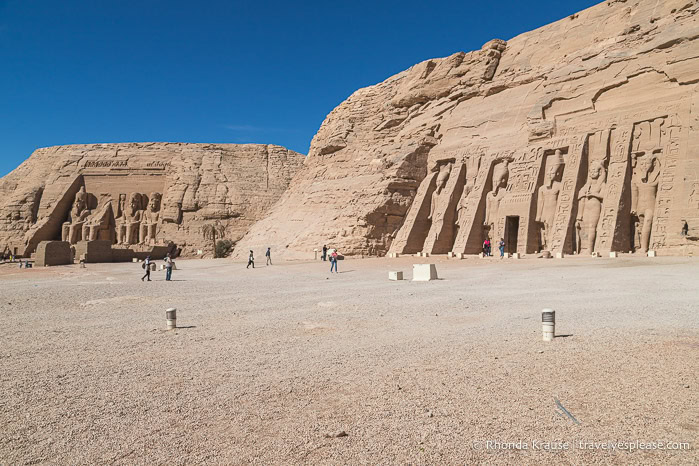
Tips for Visiting Abu Simbel
Location: The Abu Simbel temple complex is located on the bank of Lake Nasser in the village of Abu Simbel. The site is 283 km from central Aswan.
Getting There: Abu Simbel can be reached by road or plane from Aswan.
- If going by vehicle, hiring a driver or going on an organized group tour is easiest, but you could also take the bus. The drive to Abu Simbel from Aswan takes about 3.5 hours, but allow up to 4 hours with rest stops and checkpoints. For safety on the road to Abu Simbel, it’s required that tourist vehicles have two available drivers and that they wait at the checkpoint outside Aswan in the morning to form a convoy. My guide told me that the road leaving Abu Simbel closes at a certain time (3:00 pm in January) and that vehicles don’t need to convoy back to Aswan if it’s not dark.
Best Time to Visit: Most people visit Abu Simbel on a day trip from Aswan, leaving really early in the morning. I visited in January, and in my experience, there were a lot of people at 9:00 am (an hour after the temple opened), but it got less busy at 10:00 am when tour groups were already leaving. I was happy arriving at opening time, but later in the afternoon might not be too crowded because of the heat.
Opening Hours and Tickets: Current opening hours and ticket prices can be found here.
Amenities: At the entrance, there is a visitor centre with some informative displays, a very overpriced cafe, and some souvenir stalls. I recommend bringing your own drinks and snacks for the day.
Information was correct at the time of publishing, but can change without notice. Please confirm directly with service providers.
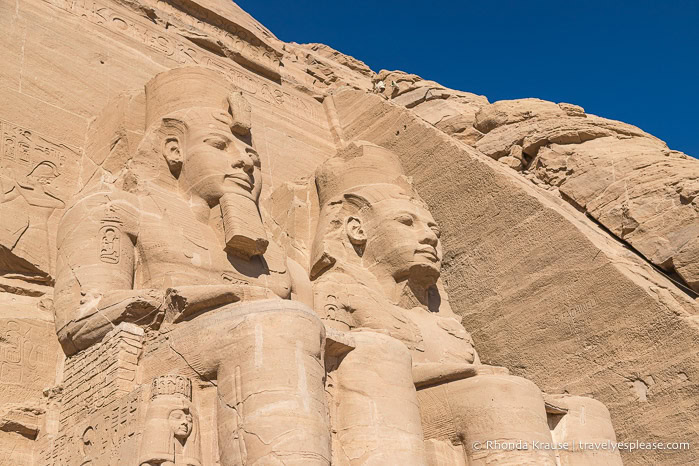
Tours to Abu Simbel
A convenient way to visit Abu Simbel is by booking a package deal from a tour operator or private guide that includes transportation from Aswan, hotel pick up and drop off, admission tickets, and a guided tour of the temples. Here is a trusted site where you can book a day trip to Abu Simbel.
Accommodations in Aswan
For your convenience, here is a list of hotels in Aswan and Abu Simbel. Please consider booking your Aswan or Abu Simbel accommodations through the included link. It costs nothing extra and helps support this website. Thank you!
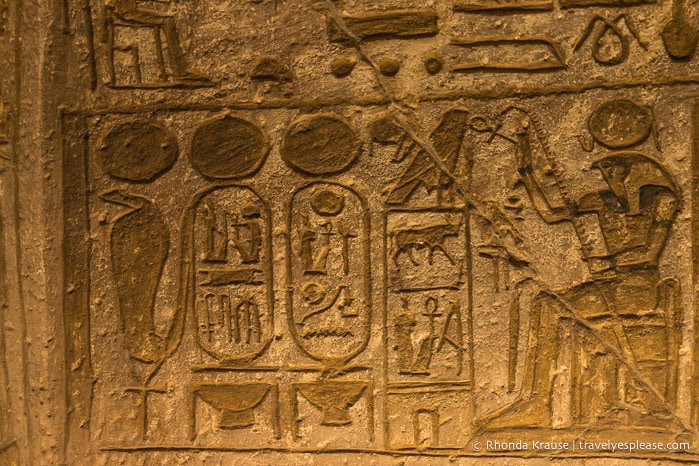
More Egypt Destinations and Travel Guides
- Philae Temple Sound and Light Show- Review and Tips for Attending
- Visiting Whale Valley- Discover Wadi Al-Hitan’s Whale Fossils
